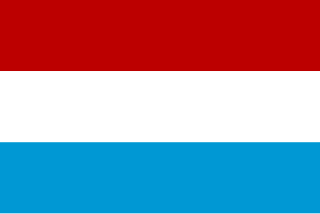
New Netherland was a 17th-century colonial province of the Dutch Republic located on the east coast of what is now the United States. The claimed territories extended from the Delmarva Peninsula to southwestern Cape Cod, while limited settlements were in parts of the U.S. states of New York, New Jersey, Delaware, and Connecticut, with small outposts in Pennsylvania and Rhode Island.
The history of New York City has been influenced by the prehistoric geological formation during the last glacial period of the territory that is today New York City. The area was long inhabited by the Lenape; after initial European exploration in the 16th century, the Dutch established New Amsterdam in 1626. In 1664, the British conquered the area and renamed it New York.

The seal of New York City is the city's official corporate insignia. According to the city's Administrative Code, it is used to identify documents or publications issued under the authority of the city or its departments. It is also engraved into property owned by the city, used to identify officers of the city, and featured on the city's flag.
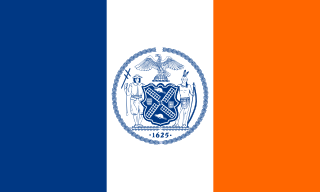
The flags of New York City include the flag of New York City, the respective flags of the boroughs of The Bronx, Brooklyn, Manhattan, Queens, and Staten Island, and flags of certain city departments. The city flag is a vertical tricolor in blue, white, and orange and charged in the center bar with the seal of New York City in blue. The tricolor design is derived from the flag of the Dutch Republic—the Prince's Flag—as used in New Amsterdam in 1625.

Arverne is a neighborhood in the New York City borough of Queens, on the Rockaway Peninsula. It was initially developed by Remington Vernam, whose signature "R. Vernam" inspired the name of the neighborhood. Arverne extends from Beach 54th Street to Beach 79th Street, along its main thoroughfare Beach Channel Drive, alternatively known as Rev. Joseph H. May Drive.

Verdi Square is a 0.1-acre (400 m2) park on a trapezoidal traffic island on the Upper West Side of Manhattan in New York City. Named for Italian opera composer Giuseppe Verdi, the park is bounded by 72nd Street on the south, 73rd Street on the north, Broadway on the west, and Amsterdam Avenue on the east. Verdi Square's irregular shape arises from Broadway's diagonal path relative to the Manhattan street grid. The western half of the park is built on the former northbound lanes of Broadway, which were closed permanently in 2003 during a renovation of the New York City Subway's adjacent 72nd Street station. Verdi Square is designated as a New York City scenic landmark and is operated by the New York City Department of Parks and Recreation.
Jessé de Forest was the leader of a group of Walloon Huguenots who fled Europe due to religious persecutions. They emigrated to the New World, where he planned to found New-Amsterdam, which is currently New York City.
New Netherlanders were residents of New Netherland, the seventeenth-century colonial province of the Republic of the Seven United Netherlands on the northeastern coast of North America, centered on the Hudson River and New York Bay, and in the Delaware Valley.
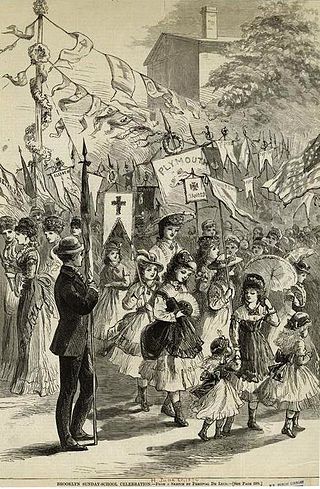
Brooklyn–Queens Day, also sometimes called Welcome Back to Brooklyn Day, Kids Day and Rally Day, was a public school holiday observed in the New York City boroughs of Brooklyn and Queens. In the New York City Department of Education's 2005 contract with the United Federation of Teachers the holiday became citywide, giving all school children the day off but requiring all city school teachers to participate in a professional development day.

The Battery, formerly known as Battery Park, is a 25-acre (10 ha) public park located at the southern tip of Manhattan Island in New York City facing New York Harbor. It is bounded by Battery Place on the north, State Street on the east, New York Harbor to the south, and the Hudson River to the west. The park contains attractions such as an early 19th-century fort named Castle Clinton; multiple monuments; and the SeaGlass Carousel. The surrounding area, known as South Ferry, contains multiple ferry terminals, including the Staten Island Ferry's Whitehall Terminal; a boat launch to the Statue of Liberty National Monument ; and a boat launch to Governors Island.

Harvard University celebrated the 300th anniversary of its founding in 1936 with elaborate festivities, hosting tens of thousands of alumni, dignitaries, and representatives of institutions of learning and scholarship from around the world.
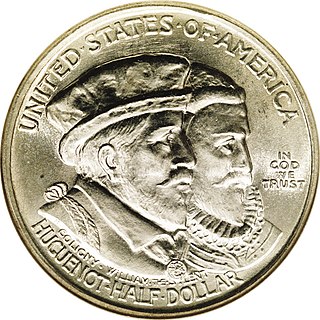
The Huguenot-Walloon half dollar or Huguenot-Walloon Tercentenary half dollar is a commemorative coin issued by the United States Bureau of the Mint in 1924. It marks the 300th anniversary of the voyage of the Nieuw Nederlandt which landed in the New York area in 1624. Many of the passengers were Huguenots from France or Walloons from what is now Belgium; they became early settlers of New York State and the surrounding area.
The Jewish arrival in New Amsterdam of September 1654 was the first organized Jewish migration to North America. It comprised 23 Sephardi Jews, refugees "big and little" of families fleeing persecution by the Portuguese Inquisition after the conquest of Dutch Brazil. It is widely commemorated as the starting point of New York Jewish and Jewish-American history.
Beaver Street is a street in the Financial District of Lower Manhattan in New York City. Beaver Street runs five blocks from Pearl Street in the east to Broadway in the west. Along its length, it crosses Hanover, William, Broad, and New Streets. The street is preserved as part of the New Amsterdam street grid, a New York City designated landmark.

New York City's waste management system is a refuse removal system primarily run by the New York City Department of Sanitation (DSNY). The department maintains the waste collection infrastructure and hires public and private contractors who remove the city's waste. This waste, created by New York City's population of more than eight million, can amount to more than ten thousand tons a day.
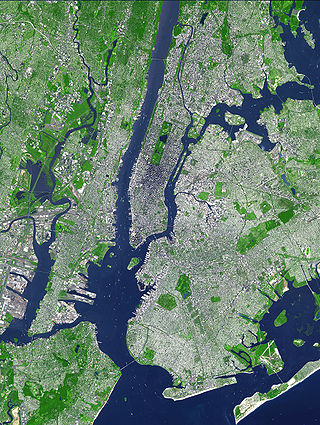
The land comprising New York City holds approximately 5.2 million trees and 168 different tree species, as of 2020. The New York City government, alongside an assortment of environmental organizations, actively work to plant and maintain the trees. As of 2020, New York City held 44,509 acres of urban tree canopy with 24% of its land covered in trees.

The Barnard Greek Games are a tradition at Barnard College, a women's college affiliated with Columbia University in New York City, New York. They were first held in 1903, when the Class of 1905 challenged the Class of 1906 to an informal athletic contest, and would be held continuously until the Columbia University protests of 1968, when the games stopped entirely. They would be revived several times after 1968, first in 1989 as part of the college's centennial celebrations. Though they began as a competition between the freshman and sophomore classes, the games would eventually expand to include the entire student body.

NY400: Holland on the Hudson was the 2009 commemoration of the 400th anniversary of Henry Hudson's 1609 expedition up the river bearing his name, that later provided the basis for the founding of New Netherland. The peak of activity in New York City was NY400 Week, September 8-13. It was also the occasion for environmental thinking, including the Mannahatta Project reconstructing the ecology of 1609 Manhattan.
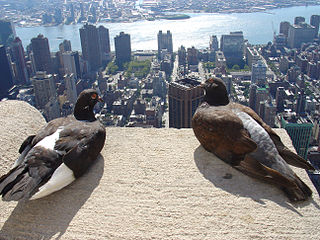
The environment of New York City consists of many interwoven ecosystems as part of the New York–New Jersey Harbor Estuary. The climate of New York City shapes the environment with its cool, wet winters and hot, humid summers with plentiful rainfall all year round. As of 2020, New York City held 44,509 acres of urban tree canopy with 24% of its land covered in trees. As of 2020, the population of New York City numbered 8.8 million human beings.














